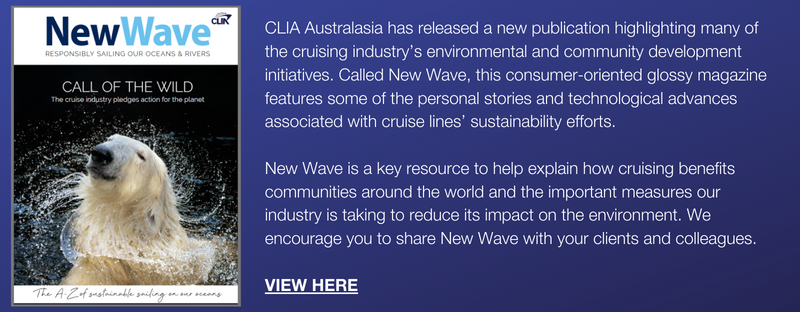CLICK HERE to view the latest findings from CLIA's 2021 Environmental Technologies and Practices Report
Cruise lines are at the forefront in developing responsible environmental practices, leading by example for the world’s shipping industry.
CLIA ocean-going cruise lines are pursuing net-zero carbon cruising by 2050 across the global fleet, and are on track to reduce the rate of carbon emissions by 40% by 2030
Innovating for a low carbon future
Investment in Research and Development (R&D), time, and collaboration is necessary for new environmental technologies to be scaled up effectively and safely. Recognizing the importance of collaboration, the cruise industry has joined other maritime associations in sponsoring a proposal for the establishment of the world’s first collaborative shipping R&D Board, which aims to generate around $5 billion over a ten-year period to pursue new environmental solutions.Modern day cruise ships are powerhouses of innovation brimming with cutting-edge technologies.The entire shipping industry benefits from the early adoption by cruise lines of new technologies that did not exist five to ten years ago. Examples include use of LNG as fuel and the introduction of the first LNG-propelled cruise ship, exhaust gas cleaning systems, advanced wastewater purification systems, air lubrication systems and special paint coatings to reduce fuel consumption, energy-efficient engines, the use of shore-side power, and much more.
The cruise industry recognizes that a robust research and development effort devoted to the near-term identification and production of new fuels, propulsion systems and related technologies is necessary to achieve zero carbon emissions in the global maritime fleet. This is not only critical to achieving the vision and specific objectives of IMO's GHG Strategy, but as part of a low carbon future.
CLIA cruise lines made a global fleet-wide commitment in December 2018 to reduce the rate of carbon emissions by 40% by 2030 compared to 2008 levels. Across the globe, the cruise industry is working diligently towards this aggressive target.
Fueling the future
The immediate future includes the introduction of alternate fuels in support of the IMO goal to achieve zero emissions.
- Use of LNG as fuel for passenger ships in port and the introduction of the first LNG-propelled cruise ship. LNG has virtually zero sulfur emissions, a 95-100% reduction in particulate emissions, an 85% reduction in NOx emissions, and up to a 20% reduction in greenhouse gas emissions. 25 LNG-powered CLIA member ships are on order or under construction. 44% of new CLIA member capacity will rely on LNG for primary propulsion.
- Advanced wastewater purification systems that use advanced tertiary-level treatment to generate effluent discharges that are often equivalent to the best shoreside treatment plants and whose use reaches well beyond international requirements.
- Use of alternative sustainable fuels and battery/hybrid power are being explored.
- Exhaust gas cleaning systems (EGCS) that reduce sulfur oxide levels by as much as 98%, typical total particulate matter of 50% or more (including elemental and organic carbon and black carbon), and nitrogen oxides by up to 12%.
Energy efficiency is a critical element in developing future climate solutions. There are many examples of energy efficiency onboard cruise ships, including:
- Air lubrication systems for ship hulls to reduce drag and fuel consumption for greater efficiency
- Energy-efficient engines that consume less fuel and reduce emissions.
- Shore-side power capability that allows ships to “plug in” when available at ports of call for overall emission reduction
- Special paint coatings for ship hulls that reduce fuel consumption by up to 5%
- Installation of tinted windows, higher efficiency appliances and HVAC systems and windows that capture and recycle heat
- Optimized itineraries affecting speed, routes and distances traveled to significantly reduce fuel consumption
- LED lighting - lasts 25 times longer and uses 80% less energy
Recycling at sea
Environmental sustainability is about more than decarbonization.
The extent of recycling on ships is often superior to that of many of the cities that the ships visit. Some ships can repurpose 100% of waste generated aboard – removing, reusing, recycling, and converting waste to energy. The extent of recycling onboard is superior to that of many cities that the ships visit, and an increasing number of cruise lines have banned single-use plastics. Cruise lines recycle 80,000 tons of paper, plastic, aluminum and glass each year.
Cruise lines carefully follow waste management and recycling practices to prevent waste in oceans.
Transparency
With the advice and consent of its members, CLIA adopted an Environmental Policy, the implementation of which, as a condition of membership, is verified annually by member cruise line CEOs. The policy is incorporated into each ship’s Safety Management System (SMS) and, accordingly, is subject to third-party and internal auditing.
Each cruise ship receives dozens of inspections each year from the ports they visit, countries where they are registered and other independent agencies — including checks of equipment and practices for waste management, emission reduction and water treatment. The cruise industry participates in International Maritime Organization (IMO) working groups and committees to develop global regulations to protect the environment.


